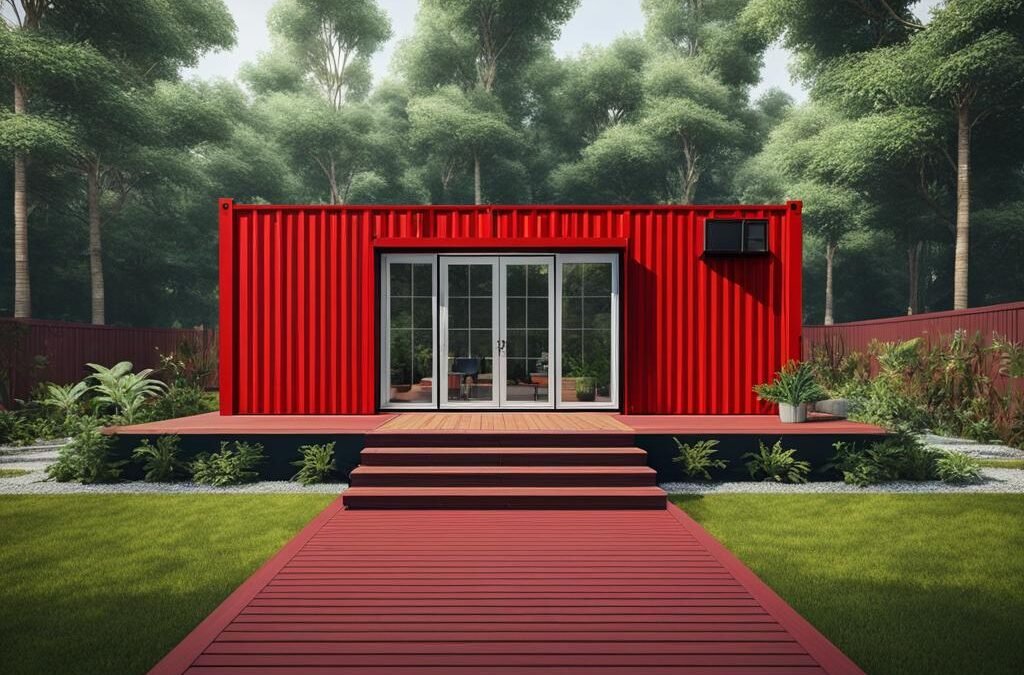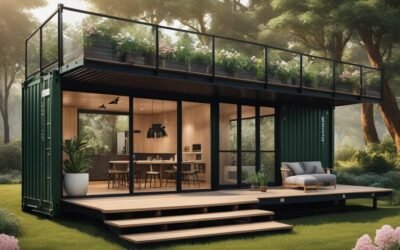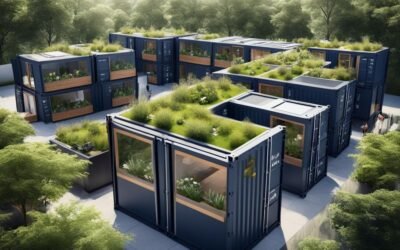Hi there! I’m excited to share my journey of transforming a 20ft shipping container into my very own home. It might sound unconventional, but let me tell you, it’s been an incredible experience. Living in a shipping container house has become a trend that offers so much more than meets the eye.
Shipping containers are not only affordable but also incredibly durable. They can withstand extreme weather conditions and offer a unique aesthetic that sets them apart from traditional homes. In this article, I’ll walk you through the pros and cons of using a shipping container as a tiny house and the step-by-step process of converting it into a comfortable living space.
Key Takeaways:
- Converting a 20ft shipping container into a home is a popular and sustainable housing option.
- Shipping containers are affordable, durable, and offer a unique aesthetic.
- The conversion process involves structural modifications, insulation, and obtaining necessary permits.
- Building a shipping container home provides cost-effectiveness and design flexibility.
- Considerations include insulation, structural integrity, and working with experienced professionals.
Benefits of Building a Shipping Container Home
Building a shipping container home comes with several practical benefits.
- Cost-Effectiveness: One of the primary advantages of choosing a modular container home is its affordability. Shipping containers are readily available at a lower cost compared to traditional homes, making it an attractive housing option for those on a budget.
- Modularity and Customization: The modular nature of shipping containers allows for easy expansion and customization. Whether you require additional living space or want to design a unique layout, container homes offer the flexibility to meet your specific needs and preferences.
- Durability and Weather Resistance: Shipping containers are built to withstand the rigors of long-distance transportation. Their robust construction makes them durable and weather-resistant, providing a secure and reliable housing option that can withstand various environmental conditions.
- Low Maintenance: Unlike traditional homes that may require constant upkeep and repairs, container homes are relatively low-maintenance. The materials used in container construction are resistant to pests, rot, and other common issues, reducing the need for frequent maintenance.
- Sustainability and Eco-Friendliness: Building a shipping container home promotes sustainable living. By repurposing used containers, you contribute to recycling efforts and reduce the demand for new construction materials. Additionally, container homes can be designed with energy-efficient insulation, minimizing energy consumption and lowering your carbon footprint.
“Building a shipping container home provides an opportunity to create a unique and environmentally-friendly living space.”
Whether you are looking for an affordable housing solution, a customizable living space, or an eco-friendly home, a modular container home offers a range of benefits. With their durability, versatility, and sustainability, these homes provide an opportunity to embrace a more conscious and innovative approach to housing.
Planning and Building Process of a Shipping Container Home
 When it comes to turning a shipping container into a home, careful planning and a systematic building process are crucial for a successful project. From obtaining permits to selecting the right container, each step plays an important role in creating a functional and comfortable living space.
When it comes to turning a shipping container into a home, careful planning and a systematic building process are crucial for a successful project. From obtaining permits to selecting the right container, each step plays an important role in creating a functional and comfortable living space.
Here is a breakdown of the planning and building process:
1. Obtaining permits and consulting professionals
Before you begin the conversion process, it’s essential to obtain the necessary permits and consult with professionals such as architects and structural engineers. They will ensure that your design complies with building codes and meets safety requirements.
2. Designing the floor plan
Start by designing the floor plan of your container home. Consider the dimensions, layout, and features you want to incorporate. This is your opportunity to customize the space according to your needs and lifestyle.
3. Selecting a suitable shipping container
Choose a shipping container that meets your requirements in terms of size, condition, and type. Assess the container’s structural integrity, ensuring it is suitable for conversion into a home.
4. Preparing the land
Prepare the land where you will place the container home. Level the ground, create a stable foundation, and ensure clear access for delivery. Properly preparing the land will ensure a smooth installation process.
5. Cutting openings and adding reinforcements
Once the container is in place, cut openings for doors and windows. These openings will bring in natural light and provide ventilation. It is important to add structural reinforcements to maintain the container’s integrity after cutting.
6. Insulation, electrical, and plumbing systems
Insulate the container to regulate temperature and improve energy efficiency. Install electrical and plumbing systems to ensure a comfortable living environment. Seek professional assistance for these complex tasks.
7. Interior finishes
Add the finishing touches to your container home’s interior. Install flooring, wall coverings, and any other desired features to create a cozy and inviting space. Let your creativity shine through in the design choices.
8. Landscaping and decorating
Finally, enhance the exterior surroundings of your container home through landscaping and decorating. Create an outdoor area that complements your home’s aesthetic and enhances its functionality.
By following a well-defined planning and building process, you can transform a shipping container into a unique and charming home. The result will be a small container home that combines sustainability, functionality, and your personal style.
Considerations and Challenges in Building a Shipping Container Home
 Building a shipping container home offers many advantages, but it is crucial to be aware of the considerations and challenges they present. One major consideration is the susceptibility of metal containers to temperature changes, which can lead to uncomfortable living conditions. Proper insulation and ventilation are essential to regulate the interior temperature and ensure a comfortable living environment.
Building a shipping container home offers many advantages, but it is crucial to be aware of the considerations and challenges they present. One major consideration is the susceptibility of metal containers to temperature changes, which can lead to uncomfortable living conditions. Proper insulation and ventilation are essential to regulate the interior temperature and ensure a comfortable living environment.
The process of cutting into a container to create openings for doors and windows can also impact its structural integrity. This is where the expertise of engineers becomes crucial to ensure that the modifications do not compromise the overall stability of the container home. By working with professionals, you can ensure that your container house remains structurally sound and safe.
Choosing the right shipping container is another important aspect to consider. Factors such as size, condition, and age of the container can impact the success of your project. It is important to thoroughly inspect the containers and select ones that are in good condition, free from any structural damage or excessive wear and tear.
In addition, complex aspects such as electrical and plumbing installations require the expertise of experienced professionals. Working with professionals will ensure that these crucial systems are installed properly and meet all safety standards.
“Building a container home requires careful consideration of insulation, structural integrity, container selection, and professional assistance for complex installations. By addressing these considerations and challenges, you can ensure a successful and safe construction process for your container home.”– Jane Foster, Container Home Enthusiast
By being aware of these considerations and challenges, you can navigate the construction process of your container home with confidence. With proper planning, professionals’ assistance, and attention to detail, you can overcome these challenges and create a beautiful and functional container home that meets your needs and vision.
Conclusion
Converting a 20ft shipping container into a home offers an exciting and eco-friendly solution for those seeking an alternative living space. Despite the challenges in the construction process, the benefits of a container house, including cost-effectiveness, durability, and design flexibility, make it an appealing choice.
By following proper planning and building steps, it is possible to transform a shipping container into a cozy and comfortable small container home that perfectly suits individual needs and preferences. Whether you are looking for a minimalist retreat, a modern tiny house, or a sustainable dwelling, container homes provide endless possibilities.
With their unique aesthetics and modular nature, container houses offer an opportunity to create a truly one-of-a-kind home. Instead of conforming to traditional housing styles, a container home allows you to express your creativity, showcasing your personal style and reducing your environmental footprint.
FAQ
What are the benefits of building a shipping container home?
Building a shipping container home offers cost-effectiveness, durability, and design flexibility. It also provides sustainable and eco-friendly features, as well as the opportunity to create a unique and environmentally-friendly living space.
What is involved in the planning and building process of a shipping container home?
The planning and building process of a shipping container home includes obtaining necessary permits, consulting with professionals, designing the floor plan, selecting a suitable container, preparing the land, cutting openings for doors and windows, adding reinforcements and insulation, installing electrical and plumbing systems, and completing interior finishes.
What considerations and challenges should I keep in mind when building a shipping container home?
Some considerations and challenges when building a shipping container home include the need for insulation and ventilation, ensuring structural integrity after cutting into the container, choosing the right container in terms of size and condition, and working with experienced professionals for complex installations.













